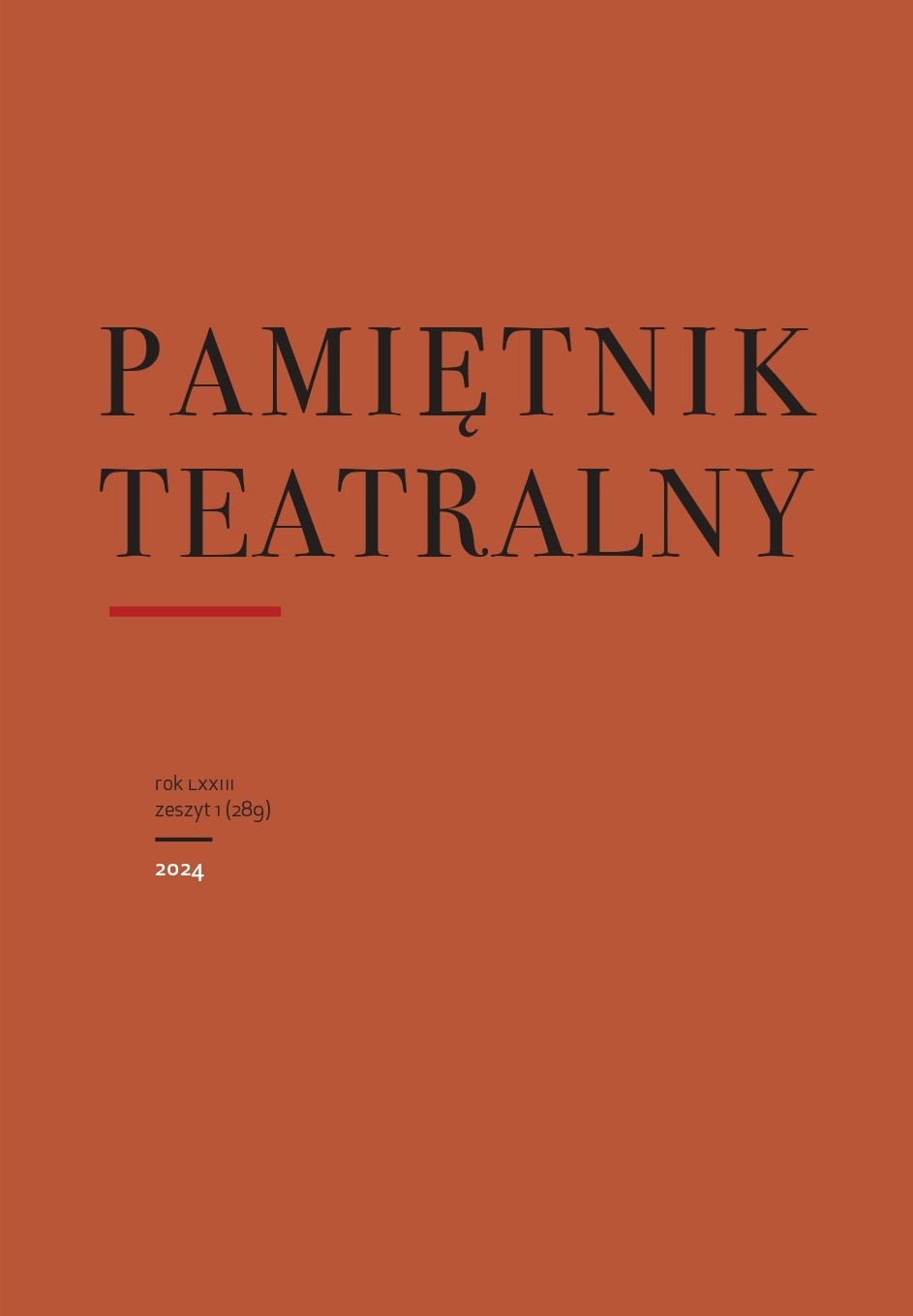Politics and the Disciplining of Spectacles: The Opera in Revolutionary France 1789– 1794
Marek Mosakowski
marek.mosakowski@ug.edu.plGdańsk University (Poland)
https://orcid.org/0000-0002-5154-7650
Abstract
This article discusses the ways in which performances were disciplined in revolutionary France between 1789 and 1794. It presents the socio-political contexts of two legal acts regulating the production and staging of plays: the relatively liberal Le Chapelier Law of 13 January 1791 and the repressive Decree of the National Convention of 2 August 1793, which turned French theater and opera into a propaganda platform of the Jacobin regime, imposing ideology and topics on the artists. The artistic practice of the time is illustrated by two operas: Étienne Nicolas Méhul’s Hadrian, Emperor of Rome and François-Joseph Gossec’s The Triumph of the Republic. The former was suspended one day before the premiere, scheduled for 13 March 1792, as the Paris Commune deemed it overtly monarchical and politically incorrect in a France where the foundations of the Bourbon monarchy were already shaking, and the extremely polarised public sentiment was about to pave the way towards a republic. The latter was composed shortly after the fall of the monarchy and staged in early 1793. The Triumph of the Republic set new aesthetic standards for French republican and patriotic opera. Gossec’s work is discussed as an example of the principles of the new cultural politics of the Jacobin dictatorship, based on unprecedented repression and censorship.
Keywords:
French Revolution, Jacobin dictatorship, French revolutionary theater and opera, revolutionary censorship, Étienne-Nicolas Méhul, François-Joseph GossecReferences
Copin, Alfred. Talma et la Révolution. Paris, 1887. https://gallica.bnf.fr/ark:/12148/bpt6k6531436j.texteImage.
Google Scholar
Darlow, Mark. Staging the French Revolution: Cultural Politics and the Paris Opera, 1789–1794. Oxford: Oxford University Press, 2012.
Google Scholar
Estrée, Paul de. Le Théâtre sous la Terreur (Théâtre de la peur) 1793–1794. Paris: Émile-Paul Frères, 1913. https://gallica.bnf.fr/ark:/12148/bpt6k5567737g/f27.item.texteImage.
Google Scholar
Graczyk, Anette. „Le Théâtre de la Révolution française, média de masses entre 1789 et 1794”. Traduction Élisabeth Landes. Dix-Huitième siècle, no. 21 (1989): 395–409. https://doi.org/10.3406/dhs.1989.1715.
DOI: https://doi.org/10.3406/dhs.1989.1715
Google Scholar
Gueniffey, Patrice. La Politique de la Terreur: Essai sur la violence révolutionnaire, 1789–1794. Paris: Fayard, 2000.
Google Scholar
Haine, Malou. „Sonorités nouvelles aux fêtes de la Révolution française”. Études sur le XVIIIe siècle 17 (1990): 193–209.
Google Scholar
Hallays-Dabot, Victor. Histoire de la censure théâtrale en France. Paris, 1862. https://gallica.bnf.fr/ark:/12148/bpt6k96035925.texteImage.
Google Scholar
Hemmings, Frederic W.J. Theatre and State in France 1760–1905. Cambridge: Cambridge University Press, 1994. https://doi.org/10.1017/CBO9780511582653.
DOI: https://doi.org/10.1017/CBO9780511582653
Google Scholar
Johnson, James H. Listening in Paris: A Cultural History. Berkeley: University of California Press, 1995.
DOI: https://doi.org/10.1525/9780520918238
Google Scholar
Kennedy, Michael. „From Casti to Capriccio: Strauss’s Theatrical Fugue”. In Words on Music: Essays in Honor of Andrew Porter on the Occasion of His 75th Birthday, edited by David Rosen and Claire Brook, 174–195. Hillsdale, NY: Pendragon Press, 2002.
Google Scholar
Martin, Jean-Clément. Nouvelle histoire de la Révolution française. Paris: Perrin, 2012.
DOI: https://doi.org/10.3917/perri.marti.2012.01
Google Scholar
Massin, Brigitte, et Jean Massin. Wolfgang Amadeus Mozart. Paris: Fayard, 1970.
Google Scholar
Mathiez, Albert. Autour de Robespierre. Paris: Payot, 1925. https://gallica.bnf.fr/ark:/12148/bpt6k940559g.
Google Scholar
Mosakowski, Marek. Sztuki w służbie terroru: O rewolucji w kulturze francuskiej w latach 1792–1794. Gdańsk: Wydawnictwo Uniwersytetu Gdańskiego, 2021.
Google Scholar
Noiray, Michel. „L’Opéra de la Révolution (1790–1794): Un «tapage de chien»?”. In La Carmagnole des Muses: L’homme des lettres et l’artiste dans la Révolution, sous la direction de Jean-Claude Bonnet, 357–383. Paris: Armand Colin, 1988.
Google Scholar
Ozouf, Mona. La Fête révolutionnaire 1789–1799. Paris: Gallimard, 1976.
DOI: https://doi.org/10.14375/NP.9782070295173
Google Scholar
Petitfrère, Claude. Le Scandale du „Mariage de Figaro”, 1784: Prélude à la Révolution française? Bruxelles: Éditions Complexe, 1989.
Google Scholar
Place, Adélaïde de. Étienne-Nicolas Méhul. Paris: Bleu nuit, 2005.
Google Scholar
Sajous d’Oria, Michèle. „Le Répertoire du Théâtre Molière, 11 juin 1791–31 octobre 1791”. Studi Francesi 169 (2013): 40–56. https://doi.org/10.4000/studifrancesi.3279.
DOI: https://doi.org/10.4000/studifrancesi.3279
Google Scholar
Trousson, Raymond. „La Saint-Barthélemy, du religieux au politique”. Romanische Forschungen 124, no. 3 (2012): 325–345. http://www.jstor.org/stable/41679462.
DOI: https://doi.org/10.3196/003581212802834878
Google Scholar
Welschinger, Henri. Le Théâtre de la Révolution: 1789–1799. Paris, 1881. https://gallica.bnf.fr/ark:/12148/bpt6k205988b.image.
Google Scholar
Žižek, Slavoj, i Mladen Dolar. Druga śmierć opery. Tłumaczenie Sławomir Królak. Warszawa: Wydawnictwo Sic!, 2008.
Google Scholar
Authors
Marek Mosakowskimarek.mosakowski@ug.edu.pl
Gdańsk University Poland
https://orcid.org/0000-0002-5154-7650
Marek Mosakowski - Associate Professor of French Literature at the Institute of Romance Philology, University of Gdansk. His research focuses on French literature of the 18th century and its links with French history, French law, French thought, and art of the Enlightenment period. He has recently published Sztuki w służbie terroru: O rewolucji w kulturze francuskiej w latach 1792–1794 (Gdańsk, 2021).
Statistics
Abstract views: 585PDF downloads: 314
License
Copyright (c) 2023 Marek Mosakowski

This work is licensed under a Creative Commons Attribution 4.0 International License.
The author grants a royalty-free nonexclusive license (CC BY 4.0) to use the article in Pamiętnik Teatralny, retains full copyright, and agrees to identify the work as first having been published in Pamiętnik Teatralny should it be published or used again (download licence agreement). By submitting an article the author agrees to make it available under CC BY 4.0 license.
From issue 1/2018 to 3/2022 all articles were published under a Creative Commons license CC BY-NC-ND 4.0. During this period the authors granted a royalty-free nonexclusive license (CC BY-ND 4.0) to use their article in Pamiętnik Teatralny, retained full copyright, and agreed to identify the work as first having been published in our journal should it be published or used again.









